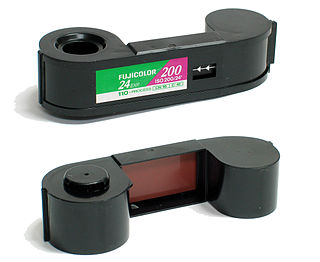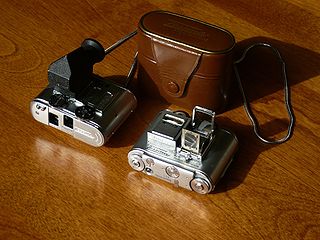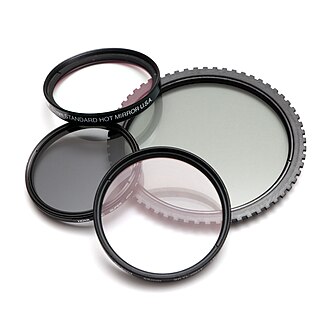Meopta Mikroma is an all metal 16mm subminiature camera made by Meopta in Czechoslovakia, after World War II. [1]
Contents


Meopta Mikroma is an all metal 16mm subminiature camera made by Meopta in Czechoslovakia, after World War II. [1]



A camera is an optical instrument used to capture an image. At their most basic, cameras are sealed boxes with a small hole that allows light in to capture an image on a light-sensitive surface. Cameras have various mechanisms to control how the light falls onto the light-sensitive surface. Lenses focus the light entering the camera, the size of the aperture can be widened or narrowed to let more or less light into the camera, and a shutter mechanism determines the amount of time the photo-sensitive surface is exposed to the light.

A twin-lens reflex camera (TLR) is a type of camera with two objective lenses of the same focal length. One of the lenses is the photographic objective or "taking lens", while the other is used for the viewfinder system, which is usually viewed from above at waist level.

110 is a cartridge-based film format used in still photography. It was introduced by Kodak in 1972. 110 is essentially a miniaturized version of Kodak's earlier 126 film format. Each frame is 13 mm × 17 mm, with one registration hole. Cartridges with 12, 20, or 24 frames are available on-line. Production variations sometimes have allowed for an additional image.
Robot is a German imaging company known originally for clockwork cameras, later producing surveillance (Traffipax) and bank security cameras. Originally created in 1934 as a brand of Otto Berning, it became part of the Jenoptik group of optical companies in 1999. In 2002 the company changed its name from Robot Foto & Electronic to ROBOT Visual Systems GmbH.

Minox is a manufacturer of cameras, known especially for its subminiature camera.

Subminiature photography is photographic technologies and techniques working with film material smaller in size than 35mm film, such as 16mm, 9.5mm, 17mm, or 17.5mm films. It is distinct from photomicrography, photographing microscopic subjects with a camera which is not particularly small.

In photography and cinematography, a filter is a camera accessory consisting of an optical filter that can be inserted into the optical path. The filter can be of a square or oblong shape and mounted in a holder accessory, or, more commonly, a glass or plastic disk in a metal or plastic ring frame, which can be screwed into the front of or clipped onto the camera lens.

Macro photography is extreme close-up photography, usually of very small subjects and living organisms like insects, in which the size of the subject in the photograph is greater than life size . By the original definition, a macro photograph is one in which the size of the subject on the negative or image sensor is life size or greater. In some senses, however, it refers to a finished photograph of a subject that is greater than life size.

The Nikon F-mount is a type of interchangeable lens mount developed by Nikon for its 35mm format single-lens reflex cameras. The F-mount was first introduced on the Nikon F camera in 1958, and features a three-lug bayonet mount with a 44 mm throat and a flange to focal plane distance of 46.5 mm. The company continues, with the 2020 D6 model, to use variations of the same lens mount specification for its film and digital SLR cameras.

The Pentax K-mount, sometimes referred to as the "PK-mount", is a bayonet lens mount standard for mounting interchangeable photographic lenses to 35 mm single-lens reflex (SLR) cameras. It was created by Pentax in 1975, and has since been used by all Pentax 35 mm and digital SLRs and also the MILC Pentax K-01. A number of other manufacturers have also produced many K-mount lenses and K-mount cameras.

The Tessina is a high-quality 35mm camera patented by Austrian chemical engineer Dr. Rudolph Steineck in Lugano Switzerland, manufactured by Siegrist in Grenchen Switzerland. It was introduced in 1957 and distributed by Steineck's company Concava S.A and remained in production up to 1996. The Tessina takes 14x21 mm pictures on standard 35 mm film, making it one of the few subminiature cameras to use the format. It is a very small (2.5x2x1 inch) twin lens reflex, with two 25 mm f/2.8 Tessinon lenses, one for taking the picture, the other for viewing on a tiny ground-glass focusing screen on top of the camera. A 45° mirror is employed to bend incoming light onto the film, which lies along the bottom of the camera rather than the back to save space. Apertures are continuously variable down to f/22, and shutter speeds range from 1/2 to 1/500, and B. The Tessina 35, Tessina L can focus down to 9 inches, Tessina Automatic 35mm to 12 inches. The film is advanced via a clockwork master spring built into the takeup spool, with a pullout winder like the crown on a wristwatch. Each winding can last up to 8 exposures.

Minolta 16 refers to a line of 16mm subminiature cameras made by Minolta between 1955 and 1974. The negative size was 10x14 mm for the earlier models, later, a larger format, 12x17 mm was adopted, using single-perforated 16 mm film. It was possible to load your own cassettes, and also develop the film using a special developing tank with a spiral insert for 16 mm film.
Edixa is a brand of camera manufacturer Wirgin Kamerawerk which was based in Wiesbaden, West Germany. The product line included several 35mm cameras and 16mm Edixa 16 subminiature cameras designed by Heinz Waaske from the 1950s to the 1970s.

In photography, a close-up lens is a simple secondary lens used to enable macro photography without requiring a specialised primary lens. They work like reading glasses, allowing a primary lens to focus more closely. Bringing the focus closer allows the photographer more possibilities.

Petie subminiature cameras were distributed by Walter Kunik of Frankfurt am Main during the 1950s and 1960s.

The Fujifilm X-mount is a type of interchangeable lens mount designed by Fujifilm for use in those cameras in their X-series line that have interchangeable-lenses. These lenses are designed for 23.6mm x 15.6mm APS-C sensors.

The Narciss is an all-metal 16 mm subminiature single lens reflex camera made by Russian optic firm Krasnogorsky Mekhanichesky Zavod (KMZ) Narciss between 1961 and 1965. It is the first subminiature SLR. It took 25 14×21 mm frames using unperforated specially spooled 16 mm film in a Narciss cassette. Compact design with interchangeable lenses and interchangeable pentaprism finders. The Narciss camera was initially designed for medical use, it included a Narciss with ordinary pentaprism finder and a second magnifier pentaprism finder for medical use; there was also a microscope adapter

Goerz Minicord is a 16 mm twin lens reflex 16 mm subminiature camera made by C.P.Goerz of Austria in 1951. It is one of the three top-quality subminiature cameras.

Gemflex is a subminiature twin lens reflex camera made by Showa Optica Works (昭和光学精機) in occupied Japan in the 1950s.

TONE camera was a sophisticated Hit-type camera using 17.5 mm paper backed film, introduced by Toyo Kobi Optical Company in occupied Japan in 1948.